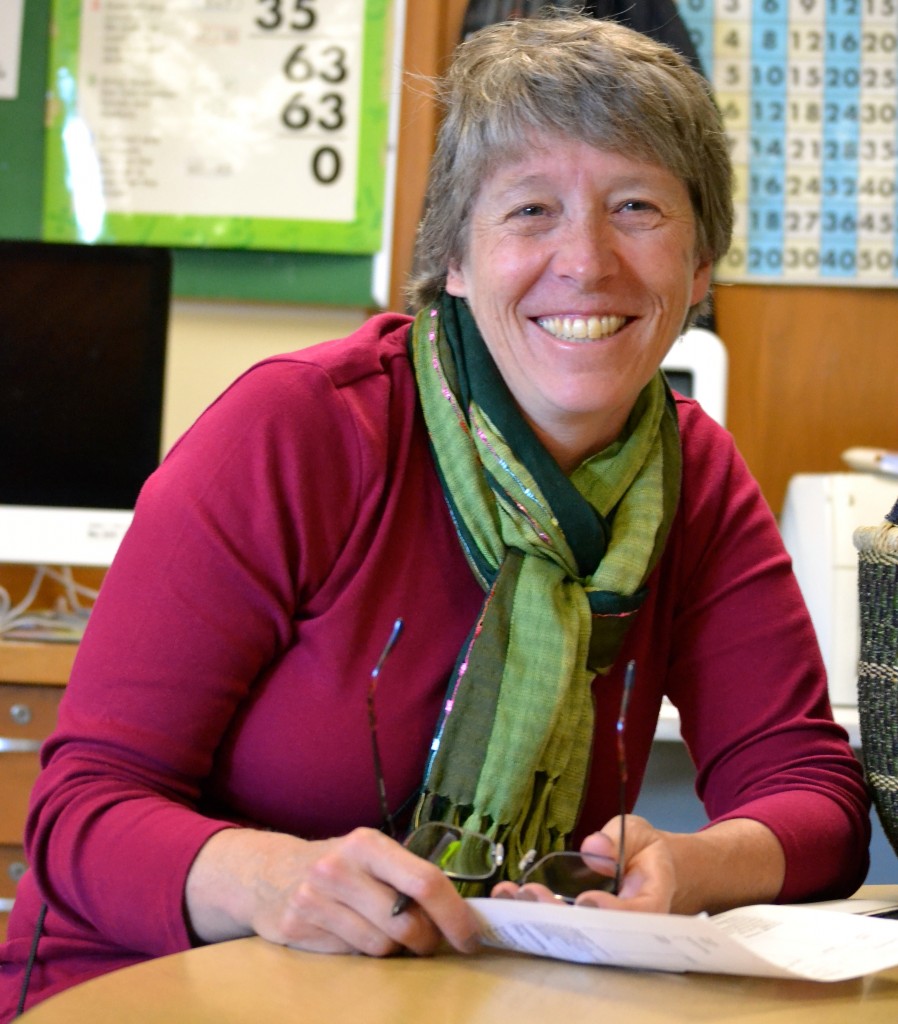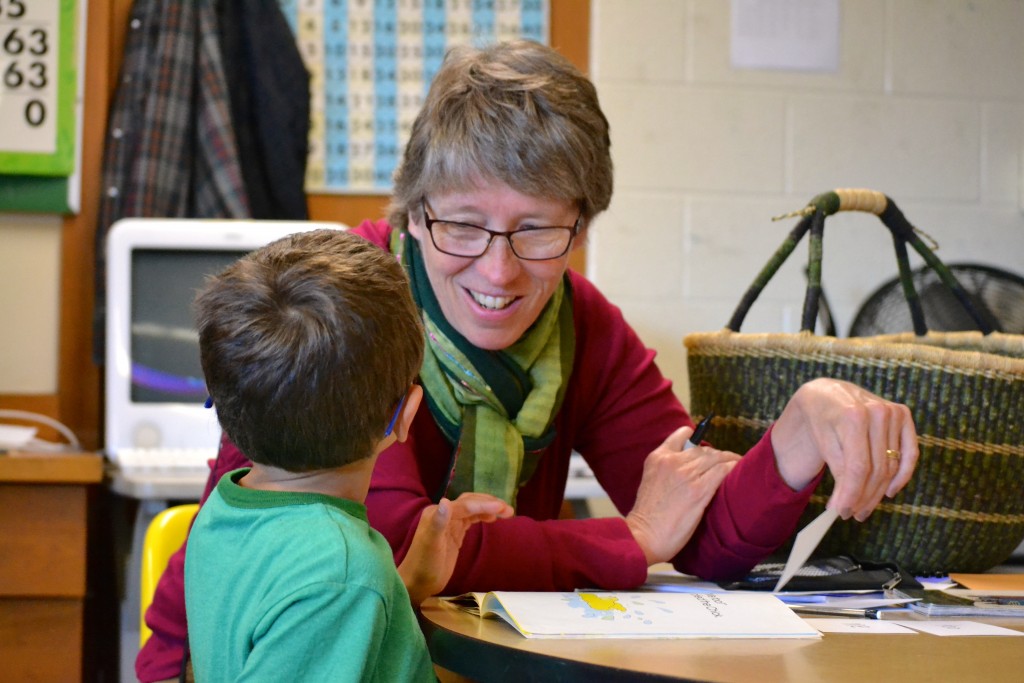

Deborah Wolter, an AAPS elementary teacher consultant, has worked with public school teachers and their students from all walks of life, including those in special education and English language learners. Prior to that, she worked as an early childhood education teacher for 10 years. Wolter has a bachelor’s degree in early childhood and elementary education and a master’s degree in reading from Eastern Michigan University. She also completed an additional endorsement in learning disabilities from Madonna University.
She lives in Dexter Township with her husband, Klaus, in a solar house they built together. Their children, Keane and Kara, are grown, so much of the couple’s personal time is spent walking, hiking, snowshoeing, cross-country skiing, biking, canoeing, and swimming around or in one of their numerous woods, rivers, creeks, and lakes.

Wolter recently wrote a book that draws on her 18 years of working one-on-one with challenged readers. “Reading Upside Down: Identifying and Addressing Opportunity Gaps in Literacy Instruction” presents case studies, along with research backing, illustrating the complexities of student learning experiences and the circumstances that shaped their acquisition of literacy in schools throughout the country.
What prompted you to write this book? Most of us will agree that the ability to read in a proficient, fluent, and engaged manner is a strong foundation for further educational and economic opportunities in our country. I taught early childhood education in the early to mid eighties and was fascinated by the burgeoning studies in emergent literacy at the time. So I returned to college for graduate degrees in reading and learning disabilities. At the same time, being deaf from birth, I am acutely aware of my luck and opportunity for an education, beginning right here in Ann Arbor Public Schools, at a time when many states had laws excluding students who were deaf, blind, emotionally impaired, developmentally disabled, or otherwise considered uneducable. Over the years of my life, both as a child and as an educator, I have seen the history of our nation’s schools move from overt segregation with the passage of the Civil Rights Act of 1964 and the Education for All Handicapped Children Act in 1975 to covert segregation with the federal and state funding for programs such as special education, Title I services, English as Second Language (ESL) classes, and other educational support programs. This book came out of my desire to point out that political attempts to address the literacy needs of our “diverse” students has resulted in school systems, as an institution, to operate with a framework of deficits, in that the problems of learning to read is intrinsic to the children themselves or their families.
In AAPS, we see that children have varying cultural, linguistic, and academic backgrounds, and by far, are not meant to be “fixed.” They are in our community to explore, to grow, and to learn.

You say that you are acutely aware of your luck and opportunity for an education, beginning right here in Ann Arbor Public Schools. Can you elaborate? Back in 1968, Thurston Elementary had a progressive and kind principal named David Aberdeen, and through his leadership, a courageous cadre of teachers all welcomed me. I was told that I was AAPS’s first student with a disability. This was well before laws were enacted to protect my rights to an education in 1975. I was lucky in that my inclusive school experience occurred squarely between the final years of overt segregation and before the years of covert segregation.
“Reading Upside Down” offers a “paradigm shift from achievement gaps to opportunity gaps in literacy instruction,” you say. Can you explain this national trend? Gaps in opportunities to learn are precursors to gaps in achievement. Too often, children nationwide who are considered “at-risk” or “struggling” are exposed to reading programs that emphasize fragmented and isolated “skills” and “sub-skills;” which in turn, do not translate into proficient, fluent, and engaged reading. Instead of being taught to read or write in an authentic and meaningful manner using real books, they are using flash cards, worksheets, and even phonics-based software. So while their peers are growing in classrooms enriched with plenty of language and literacy experiences, “at-risk” or “struggling readers” become stuck, disenfranchised, and even covertly marginalized to the point where there becomes an achievement gap. In Ann Arbor, however, there is a great effort to narrow all kinds of gaps and many of our students are reading at high levels.
People throw out the words “reading, writing and arithmetic” when they talk about the importance of getting back to basics. Are they right? And do schools give enough emphasis to reading? I am never sure what people mean by “getting back to the basics.” For some, it may mean teaching phonics as a foundation for teaching reading. Yet, phonics is only a small piece of the reading process. Proficient readers use a variety of strategies, including phonics, language structure, and semantics, to think about and have control over their reading. Proficiency also involves setting a purpose for reading, self-correcting miscues, adjusting reading speed, and monitoring comprehension. While researching for this book, I found that several studies noted that in many elementary classrooms across the country, children spend only 10 to 20 minutes per day actually reading. This is particularly concerning for children who do not read at home. If they are not reading at home and if they are not reading much at school, then they are simply not growing as readers. Fortunately, in AAPS, most of our teachers are astute in teaching multiple strategies in reading and encouraging our students to read throughout the school day.
You say school readiness is one of the eight key factors leading to reading challenges. Are some kids starting school too young? Not young enough? It is not about children being too young or young enough. It is how schools define “readiness;” it is about schools viewing some children as not ready for school. AAPS teachers take a different approach in that they are ready for all children as they come. My research for this book found that the problem with the traditional construct of reading readiness nationally is that the curriculum begins with an assumption that children already have concepts of how print works, book-handling abilities, letter recognition, phonemic awareness, and some sight word knowledge in English at the start of kindergarten or 1st grade. When the curriculum builds on this assumption, children who have not had these kinds of literacy experiences are immediately left behind. Furthermore, ethnographic studies show that not all families have the means, or the value for cultural or personal reasons, to access preschool programs. Additionally, many families bring their children to kindergarten or first grade expecting that they will learn to read at school.
Special education labeling is another factor, you say. The problem with special education labeling is that children with disabilities or health issues are first viewed through the lens of what they can’t do, as opposed to what they can do. However, according to researchers at the National Center on Educational Outcomes, a vast majority of these students can meet the same achievement standards as other students—we are talking about 80 to 85 percent of children who are eligible for special education services. Since it is often thought that children in special education can’t learn to read like their non-disabled peers, they must be taught in a specialized reading program. Unfortunately, such programs too often emphasize fragmented and isolated skills using watered-down reading material. Of course, we need to acknowledge impairments in order to remove barriers and provide accommodations, but we mustn’t forget the child behind the disability. Children with disabilities, just like their general education peers, come to school with a wide range of language and literacy experiences and a desire to learn to read and write. Today, as a teacher consultant, AAPS continues to provide excellent accommodations that I need, such as captioning services in meetings, in order for me to partake in and contribute to my work in an accessible and professional manner.
More than 1,000 AAPS students are eligible for English as a Second Language (ESL) services every year. What do you think of the ways AAPS addresses this need? We take pride in that Ann Arbor is such a culturally and linguistically diverse community. Not only that AAPS has a significant number of English language learners, there are children who are quite fluent in multiple languages. Additionally, there is a large group of children who come from homes speaking a variation of English, such as African American English. And we even have some children whose first language is American Sign Language, whether they have a hearing loss or not. AAPS has made tremendous strides in narrowing achievement gaps, reducing disproportionality, and monitoring disciplinary actions for certain population groups. In the book, I question the use of oral reading assessments that arbitrarily result in placing students in lower leveled reading groups than necessary. They need authentic and meaningful language and literacy learning experiences so much more than they may actually be receiving.
How does being deaf affect how you teach reading? How does it affect how you relate to children with challenges? Proficient, fluent and engaged reading is never done in an exacting letter-by-letter or in a word-by-word manner. So when I’m listening to—actually, lipreading—young children read, I watch for when they get stuck on words and support them with cueing strategies so they can figure it out all by themselves. When I am working with older children—those who really should not be reading aloud to adults all the time—I hold them accountable for being able to carry on a comprehension conversation, to write in their response journals, or to take good notes. I think when my students are not constantly stopped and corrected, they begin to trust me and see themselves as readers—as resilient readers who make mistakes and can still carry on with their reading.
What are the three most important things you’d like readers to take away from your book? I would like educators, administrators, therapists, and parents to listen carefully to what their inner voices might say about children who are thought to be “at-risk” or “struggling.” Instead, they should think of how schools can provide the kinds of inclusive, safe, and restorative environments that assure true opportunities for exploring and growing language and literacy.
I would like educators, particularly remedial, intervention, or special education teachers, to focus on developing short-termed and effective reading “lessons” for children in that they are teaching specific and individualized skills in an authentic and meaningful manner using real and interesting books, newspaper or magazine articles, online sources, and other texts.
I feel that everyone—teachers, administrators, and community members—should support reading and writing instruction that is open-ended, engaging, and inclusive so that all children are explorers of language and literacy and participating as viable members of their school community.

How fortunate for Ann Arbor children that Ann Arbor Public Schools had the wisdom to hire such a thoughtful, mindful and caring person who takes the time to find out what specific issue each child has to better teach them, and positively enrich their lives and increase the skills of their other teachers too! Then goes out of her way to share this information with the world in an easy to read and understand book. This could easily be a game changer, to significantly impact our current one-size-fits all educational approach, when it clearly doesn’t.
Kudos to everyone involved, especially Deborah L. Wolter. Cheers!